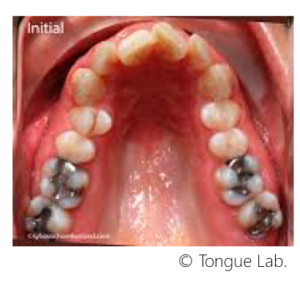Palate
The oral cavity, and more particularly the palate, is shaped by the forces of the tongue. A dysfunctional tongue does not achieve sufficient lateral expansion forces. The jaws and palate are then too narrow to accommodate the tongue and the teeth do not have the space to align properly. The palate develops in depth and, being the floor of the nasal cavities, they do not widen either. These conditions promote oral breathing.
Description
The palate forms the upper wall of the oral cavity. It consists of two parts: the hard or bony palate, located at the front, and the soft palate (or veil) at the back, itself consisting of a membrane that extends: the uvula.

Throughout the growth process, the bony palate is shaped in width by the lateral forces that the tongue exerts on the molars. The vault of the palate is also the floor of the nasal cavities. When the tongue works properly, it contributes to the harmonious development of the face and the proper functioning of the nasal cavities; it allows natural breathing through the nose. On the other hand, an atypical swallowing does not exert these lateral forces.
When the tongue works properly, it contributes to the harmonious development of the face and the proper functioning of the nasal cavities
Conséquences
This lack of lateral growth of the palate, which does not widen, becomes narrow and deep, contributes on the one hand to a long and thin face, and on the other hand to making the nasal cavities narrow. This prevents normal breathing through the nose and promotes oral breathing, which causes many conditions.
Treatment
The orthodontist’s transverse expansion of the palate exerts a force on the lateral teeth to widen the palate. Its objectives are to free up space for teeth and to encourage nasal breathing.
In the absence of functional reeducation, the tongue does not position itself against the molars and does not counterbalance the inward forces exerted by the cheeks. The results of orthodontic treatment may then lack stability inwards. Oral breathing and dental clutter can then recur.
Lire les autres chapitres :

